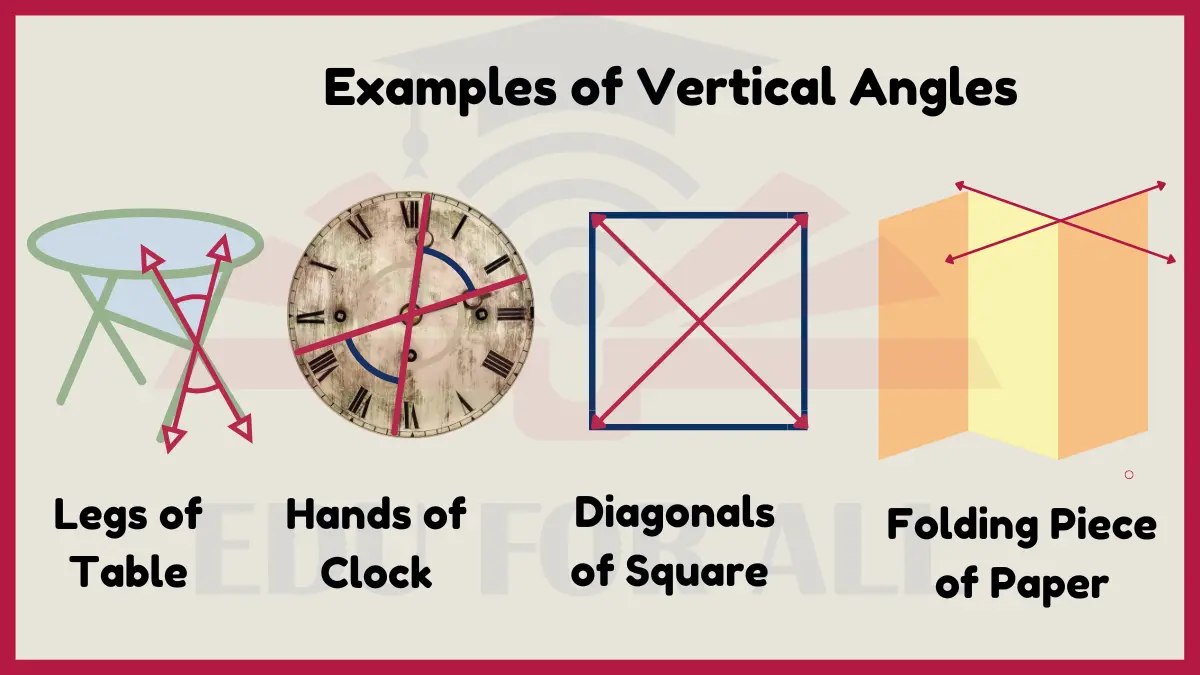Some real-life examples of vertical angles are the corners of a picture frame, the angles formed by intersecting streets forming an X-shape, the angles in legs of a chair, and the angles where the blades of scissors intersect at pivot point.
In all of these examples, the vertical angles are equal in measure and opposite each other at the point where the lines intersect.

Read Common Examples of Angles
Examples of Vertical Angles
Here are 10 real-life examples of vertical angle:
1: Legs of Table
The legs of a table form vertical angles where they connect. For example, if you look at the point where two table legs meet, the angles between the legs are vertical angles.
Experiment: Set a table right-side up. Look at one point where two legs come together and observe the angles between the legs. Rotate the table or move to each leg joint to see that the angles between the legs at each joint are equal. This happens because the legs form vertical angles where they meet.
2: Hands of Clock
The hour and minute hands on an analog clock form vertical angles as they rotate around the clock. For example, if the hour hand points to the 3 and the minute hand points to the 6, the angles between the hands are vertical angles.
Experiment: Cut arrows out of paper to represent clock hands. Push a brad through the arrows and a circle to connect them at the center. Rotate the arrow “hands” to any times and observe that the angles between the arrows are always equal. This is because clock hands form vertical angles as they rotate.
3: Intersecting Streets
Two streets that cross each other form vertical angles at the intersection. For example, two perpendicular streets would have four 90 degree angles at the corner which are vertical angles.
Experiment: Use strips of tape or long pieces of string to model intersecting streets on the ground. Observe the equal angles formed at the point where the streets “intersect.” Rotate the streets and notice the angles remain equal.
4: Diagonals of Square
The diagonals of a square intersect at the center to form four vertical angles. All four angles where the diagonals cross have the same value.
Experiment: Cut a square out of paper. Mark the diagonals with colored pencils. Observe the equal angles where the diagonals intersect. Rotate or flip the square and notice the four angles are still equal. This is because of vertical angles.
5: Folding Piece of Paper
When you fold a piece of paper, the creases form vertical angles. The angles between the folds and the paper are equal at the point they intersect.
Experiment: Fold a piece of paper in half or in quarters. Mark the fold lines and unfold. Observe the angles between the crease lines where they intersect in the middle. They are equal because they form vertical angles.
6: Leaning Tower of Pisa
The famous leaning tower of Pisa forms vertical angles between its leaning side and the ground. So if you know the angle between the tower and ground on one side, you automatically know it on the other side because they are vertical.
Experiment: Lean a paper cup over on a table. Measure the angle between the cup and the table on one side. Then measure the angle on the other side. They will be equal because they are vertical angles formed by the leaning cup.
7: Crossing Tree Branches
When tree branches grow across each other, they often form vertical angles where they intersect. The angles between the branches will be equal.
Experiment: Collect 2 sticks from outside that cross each other. Observe the angles between them where they cross. Flip them over while keeping them crossed to see the angles are equal. This is because branches form vertical angles.
8: Four Corners of Picture Frame
A rectangular picture frame forms 4 vertical angles where the corners of the frame meet. For example, the top and bottom corners have equal angles between them from the vertical sides.
Experiment: Cut a rectangle out of paper. Mark the angles between the edges of the paper at the corners with pencils. Observe that opposite angles are equal because they form vertical angles.
9: Scissors Blades
As scissors open and close, the sharp blades form vertical angles between them. So when the scissors are halfway open, the angles between the blades on each side are equal.
Experiment: Using safety scissors, keep the angles equal by carefully opening and closing them while watching the blade angles. Notice how the angles between the blades stay the same on both sides due to the vertical angle formed.
10: Goal Posts on Sports Field
The two vertical goal posts and the field or crossbar form vertical angles where they meet. So if you know the angle between the crossbar and one upright, you automatically know the angle between the crossbar and other upright due to them being vertical.
Experiment: Lean 2 pencils or sticks to represent angled goal posts. Measure the angles between one “goal post” and where it crosses the other. Then measure the angle between the other “goal post” and the crossing point. The angles will be equal due to forming vertical angles.
Also Read

